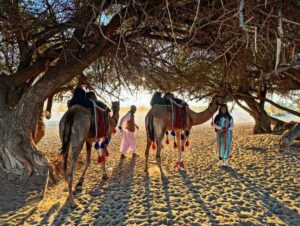The Nepal Tourism Board’s vague announcement banning independent trekkers has brought confusion and anxiety to international outfitters and especially to would-be hikers getting ready to fly to Nepal.
There is uncertainty about whether the measure applies only to solo trekkers or also to independent (non-guided) tourists in groups of two or more. And to what extent will the Khumbu region possibly skirt this mandate?
Below, we try to provide some answers for those intending to visit Nepal after April 1.

Trekkers are essential to Nepal’s tourism industry. Photo: Shutterstock
The official document
First, here is the official document from Nepal Tourism Board (NTB):

What does it mean?
- As stated, note that the measure applies to ALL independent trekkers, not just solitary individuals. Any foreign trekker has to hire a guide in order to hike the “protected mountain areas” of Nepal. These areas would include several national parks such as Sagarmatha National Park, Langtang NP, Shey Phoksundo NP, and Makalu Barun NP, and Conservation Areas such as Annapurna’s, Kangchenjunga’s, Manaslu’s, Api-Nampa’s and Gauriskankar’s. Here is a list of all protected areas of Nepal, including its lakes, hills, historical sites, and wildlife sanctuaries.
- The guide’s services must be arranged through “authorized trekking agencies registered with the government of Nepal”. That specification requires caution by those hoping to obtain the TIMS card first, then find a private guide, hoping to save some money. Official agencies will take care of everything, including the TIMS card, but at a higher price. Sources from NTB estimate that a guide changes $25 to $50 a day, but possibly much more for longer treks. That amount may be unaffordable for visitors on a shoestring budget. Group fees vary, depending on the trek. The popular Annapurna circuit costs from $850 to $1,100 for those joining a group guided by a local agency. If an individual trekker, a couple, or a small group hires a private guide, the fee is likely higher.
- Not surprisingly, the fee for the TIMS card has doubled. Now, it is 1,000 Nepal rupees for SAARC citizens (residents of South East Asia), and 2,000 rupees for the rest (except for diplomats, who are exempt from payment).
- Authorities justify the new restriction as a safety measure, but there is no mention of how this improves safety. In recent days, NTB members noted some incidents suffered by independent trekkers in the past that could lead to a “misperception” of Nepal as unsafe. However, it seems pretty obvious that the measure, agreed on with local operators and unions, is mainly to increase revenue.
- NTB promises to provide further details “shortly,” but it is already rather late. Most trekkers planning to go to Nepal this spring have already bought their plane tickets. Some of them are on a tight budget. Those who are still uncommitted might discard Nepal in favor of other destinations where they can explore freely.
How about the Everest region?
Dawa Steven Sherpa of Asian Trekking told ExplorersWeb that the Khumbu Valley remains unaffected. Home to some of the most stunning mountain scenery in the Himalaya, including Everest and Ama Dablam, the municipality doesn’t require TIMS cards. Instead, it levies a regional fee, to be paid on arrival in Lukla and combined with the entrance fee to Sagarmatha National Park.

Trekkers wait to enter Sagarmatha National Park. Photo: Shutterstock
Billi Bierling of The Himalayan Database is unsure whether this Everest exemption will continue in the future. “It was like that until last year, but I am not sure how the new regulations will apply,” she said. “You never know in Nepal.”
To learn more, ExplorersWeb asked some Sherpa mayors in the Khumbu.
“Individual tourists are heartily welcome and free to travel in the Khumbu region,” Laxman Adhikari, ward chairperson of the Khumbu Municipality, told us. “All they have to pay is 2,000 rupees for a municipality-managed Trek Card, and 3,000 rupees to trek in Sagarmatha National Park.”
The Khumbu Trek Card, a local version of the TIMS card, began last year. Issued by the Pasanglhamu Rural Municipality, it is mandatory for all foreign trekkers. Sagarmatha National Park requires another fee for entry.
These do not require visitors to be accompanied by a guide, in part because the Trek Card has a tracking system. The Khumbu region is one of the most popular in Nepal. Its many routes include the trail to Everest Base Camp and the Kala Pattar. The path to Gokyo Lakes, at the foot of Cho Oyu’s south side, en route to the coveted Three Passes trek is also in this part of Nepal.

The Khumbu Smart Trek Card cost 2,000 rupees but has no restrictions for non-guided trekkers
Reactions
The Trekking Agencies Association of Nepal (TAAN) has applauded the measure, but among stakeholders and trekkers, opinions are not so enthusiastic. Many point out that trekking is free in most other mountain areas of the world. Others believe that self-sufficiency is at the core of the trekking experience and do not wish to be guided around.
Some recall is not the first time Nepal has foisted peculiar new rules without warning shortly before the beginning of the spring season. A few years ago, it suddenly became forbidden to photograph members of other mountain expeditions.

A trekker in the Annapurna region. Photo: Shutterstock
“Don’t push it,” The Kathmandu Post headlines an op-ed piece. It advocates letting visitors decide whether they want a guide or not.
“Nepal has long been touted as one of the cheaper adventure destinations in Asia, yet it is getting costly, even by South Asian standards,” the paper wrote. “Time may thus have come to rethink how the country projects its image as a tourist destination [but] we cannot chop and change our rules for incoming tourists without having a long-term vision for Nepali tourism.”






